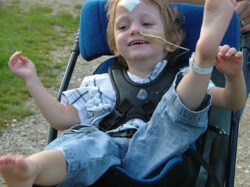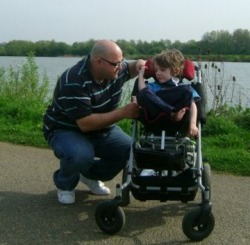Hi my name is Erkan Mustafa and I used to play the role of Roland Browning in Grange Hill for six years from 1981-1987, some of the best times of my life! Well late last year I had been challenged by my fellow ex cast member of Grange Hill to put a reunion night party for the ex pupils and teachers from the show to celebrate the past 30 years. Never one to turn down a challenge, I started to work on putting the reunion together.
LOGAN

Hi my name is Logan or, as my mummy calls me, Loggie bear. You can call me Loggie. I was born on the 19th of December 2003. So that makes me five years old. I was a normal happy smiling baby for the first 12 months of my life. I could walk, talk and say words like Mummy, Daddy and Chesca, that’s my big sister’s name. She loves me very much.
It was around my first birthday that I had my first seizure. Mummy and Daddy were scared, they rushed me to a big building called a hospital to see some doctors. I was in my Mummy’s arms and Mummy was telling the doctors all about the fits that I was having, but the doctors didn’t know what to do. Mummy took me to hospital many times. She told them all about the fits, but the doctors didn’t listen to what my Mummy was saying. It was only a kind physiotherapist that listened and she said that she would help.
After some time, the doctor said that I was having infantile spasms but they soon changed their mind. The doctors did some tests and said that I had ‘Myoclonic Astatic Epilepsy’. They gave me some medicine to take, to try a control my seizures, but the medicine didn’t work as I was still having lots of fits.
Then I had to go to Great Ormond Street Hospital and see more doctors and have yet more tests, which was not fun. I was scared as I did not like hospitals or having tests. The doctor told Mummy that I did not have ‘MAE’, they were now investigating for ‘SMEI’, which is ‘Sever Myclonic Epilepsy of Infancy’ and is when children have lots of seizures
I have many different types of seizure; head drops, tonic, clonic and Myclonic. Myclonic ones are not nice as my arms normally go backwards, my muscles at the front of my body contract then my body falls down. It is nearly always my head that hits the floor first which is not nice as I have hurt myself loads of times. Now I have to wear a funky hat to protect my beautiful face and head. Also, when I go out I always have oxygen with me as this helps me after I have bad seizures. .... TO READ MORE OF THIS LITTLE BRAVE BOY CHECK OUT
http://www.grangehillreunion.org/loggie_bear.html
It was around my first birthday that I had my first seizure. Mummy and Daddy were scared, they rushed me to a big building called a hospital to see some doctors. I was in my Mummy’s arms and Mummy was telling the doctors all about the fits that I was having, but the doctors didn’t know what to do. Mummy took me to hospital many times. She told them all about the fits, but the doctors didn’t listen to what my Mummy was saying. It was only a kind physiotherapist that listened and she said that she would help.
After some time, the doctor said that I was having infantile spasms but they soon changed their mind. The doctors did some tests and said that I had ‘Myoclonic Astatic Epilepsy’. They gave me some medicine to take, to try a control my seizures, but the medicine didn’t work as I was still having lots of fits.
Then I had to go to Great Ormond Street Hospital and see more doctors and have yet more tests, which was not fun. I was scared as I did not like hospitals or having tests. The doctor told Mummy that I did not have ‘MAE’, they were now investigating for ‘SMEI’, which is ‘Sever Myclonic Epilepsy of Infancy’ and is when children have lots of seizures
I have many different types of seizure; head drops, tonic, clonic and Myclonic. Myclonic ones are not nice as my arms normally go backwards, my muscles at the front of my body contract then my body falls down. It is nearly always my head that hits the floor first which is not nice as I have hurt myself loads of times. Now I have to wear a funky hat to protect my beautiful face and head. Also, when I go out I always have oxygen with me as this helps me after I have bad seizures. .... TO READ MORE OF THIS LITTLE BRAVE BOY CHECK OUT
http://www.grangehillreunion.org/loggie_bear.html
DRAVET SYNDROME
What is Dravet Syndrome? Dravet syndrome, also called severe myoclonic epilepsy of infancy (SMEI), is a severe form of epilepsy. It appears during the first year of life with frequent febrile seizures – fever-related seizures that, by definition, are rare beyond age 5. Later, other types of seizures typically arise, including myoclonus (involuntary muscle spasms). Status epilepticus – a state of continuous seizure requiring emergency medical care – also may occur. Children with Dravet syndrome typically experience poor development of language and motor skills, hyperactivity, and difficulty relating to others.
In 30 to 80 percent of cases, Dravet syndrome is caused by defects in a gene required for the proper function of brain cells. Borderline SMEI (SMEB) and another type of infant-onset epilepsy called generalized epilepsy with febrile seizures plus (GEFS+) are caused by defects in the same gene. In GEFS+, febrile seizures may persist beyond age 5.
Is there any treatment? Seizures in Dravet syndrome are difficult to control, but can be reduced by anticonvulsant drugs. A ketogenic diet, high in fats and low in carbohydrates, also may be beneficial.
What is the prognosis? As children with Dravet syndrome get older, their decline in cognitive function stabilizes, and in many, it improves slightly. However, most teenagers with Dravet syndrome are dependent on caregivers. The degree of cognitive impairment appears to correlate with the frequency of seizures.
What research is being done? The NINDS conducts and supports a broad program of basic and clinical research on all types of epilepsy, including Dravet syndrome. Study of the genetic defects responsible for Dravet syndrome and related disorders is expected to lead to the development of effective drug therapies
In 30 to 80 percent of cases, Dravet syndrome is caused by defects in a gene required for the proper function of brain cells. Borderline SMEI (SMEB) and another type of infant-onset epilepsy called generalized epilepsy with febrile seizures plus (GEFS+) are caused by defects in the same gene. In GEFS+, febrile seizures may persist beyond age 5.
Is there any treatment? Seizures in Dravet syndrome are difficult to control, but can be reduced by anticonvulsant drugs. A ketogenic diet, high in fats and low in carbohydrates, also may be beneficial.
What is the prognosis? As children with Dravet syndrome get older, their decline in cognitive function stabilizes, and in many, it improves slightly. However, most teenagers with Dravet syndrome are dependent on caregivers. The degree of cognitive impairment appears to correlate with the frequency of seizures.
What research is being done? The NINDS conducts and supports a broad program of basic and clinical research on all types of epilepsy, including Dravet syndrome. Study of the genetic defects responsible for Dravet syndrome and related disorders is expected to lead to the development of effective drug therapies
CHERRYLODGE CANCER CARE

Cherry Lodge Cancer Care is a charity committed to improving the quality of life for those living with cancer, their carers and families. Although our Information and Resource Centre is based in the heart of Barnet, we cover much of North London and South Hertfordshire

